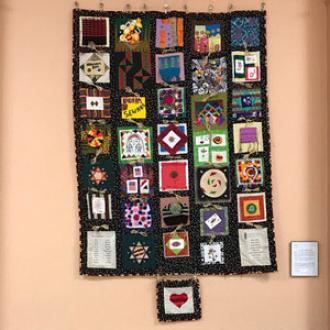
Halima Chalihou, now in her forties, is a remarkable embroiderer working with RAW. Abundant information on Halima is available in the Rodgers and Umunna Refugee Artisans of Worcester: Path to Empowerment booklet, which we rely on here (Rodgers and Umunna, 2017, 9-10). As we noted there, Halima is a devout Muslim woman from the Fulbe ethnic group of the Central African Republic (CAR). Embroidery has been a constant in Halima’s life. She learned to sew while in school in the CAR, she told us in 2017. In a July 2022 interview, we learned that a neighbor also taught her to do embroidery. Because of French colonization, the embroidery she learned in school has many French influences, as well as being shaped by African kuba cloth. In the refugee camp in Chad, Halima used her skills to embroider for cash, showing her entrepreneurial spirit far before her work with RAW. She made “window and door curtains, wall hangings, food covers, and baby blankets” and baby clothes (Rodgers and Umunna, 2017: 9).
In the refugee camp. Halima was not working directly in a craft house; rather, she worked out of her own home. A natural businesswoman, Halima opened her home there to teach women in the camp how to embroider. They then would go out and make their own products to sell.
After her arrival in Worcester, Halima continued to embroider and her partnership with RAW has encouraged her self-confidence as a businesswoman. This is important, for she is very shy when talking to others outside her household. Currently, she still produces baby blankets, as well as embroidered greeting cards, wall panels, and jean jackets. When it comes to embroidering jean jackets, Halima found this to be a difficult challenge. The denim is thick and is therefore harder to pierce with a sewing needle than linen, especially the panels of jackets with multiple layers of denim. Like many RAW embroiderers, Halima does not use any hoop or frame to hold the fabric taut. She instead holds the fabric in her hand and embroiders from there. She has tried using an embroidery hoop but prefers this way instead.
Her work on this project and her RAW crafts demonstrates her willingness to branch out and react to market demands, while also staying true to what she wants to embroider. For an October 2022 show at the Lexington MA Arts and Crafts Society, Halima embroidered a large wall hanging, which she beamed with pride about when it showing to Joan. Halima also occasionally works on commission, sending large embroidered squares in the mail to a friend in Arizona.
For RAW Halima makes carefully embroidered insets to create greeting cards to sell. Halima’s embroidery is characteristically bright and colorful. She uses a limited variety of stitches, sticking to chain stitches and a tufted technique, known as “Kasai velvet (cut loop pile)” (Rodgers and Umunna, 2017, 9), or by tapis bello, which roughly translates to “beautiful carpet” in French. To make the tufting effect, Halima must sew in layers by color, working from the inside of the design, out. She usually does two to four multicolored layers. After this is complete, she then cuts the thread at the top.
According to Halima, this is the most challenging part of her embroidery. This technique has a long history of use in Africa and internationally, but it is not just an ancient tradition. It is very much alive and modern, as evident in Halima’s design and its continued use in the CAR.
Another notable technical detail: Halima does not use French knots in her work. As Joan Kariko told us, the beauty in Halima’s work comes more from her use of colors, the patterns she creates, and the tufting work rather than from the complexity of the stitches. When asked what her favorite color to embroider with was, Halima smiled and instantly answered, “Green!” As green is a color that symbolizes Islam, it is telling of how Halima’s devout religious identity, personality, interests, and tastes influence her work. She is indeed a devoted and knowledgeable Muslim.
Even when green thread is not delivered to Halima, she finds a way to incorporate green into her work. Joan jokes that Halima must have a secret stash. Halima especially enjoys working with thinner threads. When it comes to her designs, she gets them from her head rather than looking up designs on her cell phone or in books. Many of her embroideries have floral designs or stripes and spirals that play with color relationships.
Halima’s enterprising spirit does not stop with embroidery: She is eager to expand on her language skills. Already fluent in both Fulfulbe and Sango, Halima has been known to take three English Second Language (ESL) classes at once! (Rodgers and Umunna 2017, 9-10). Through African Community Education (ACE) and the Worcester Refugee Assistance Program (WRAP), she’s taking full advantage of all the English language learning opportunities she has in the city. She practices her English in conversation with neighbors and enjoys meeting other artisans through RAW. Halima’s business-savvy and her confidence shines, evident also in her highly motivated spirit and proud embroidery
Items
For more information on Kasai velvet and its history in the Congo, which neighbors CAR, as well as why it is called “velvet” in the first place, see TRC Digital Exhibitions: Kuba or Kasai 'velvet'
For more information on Kuba cloth and its influence on artists and design, as well as some history:
Finch, Christopher. 1999. “Kuba Textiles: Assessing the Boldly Patterned Designs from Africa.” Architectural Digest. Vol 56 (1). P 48-55.

